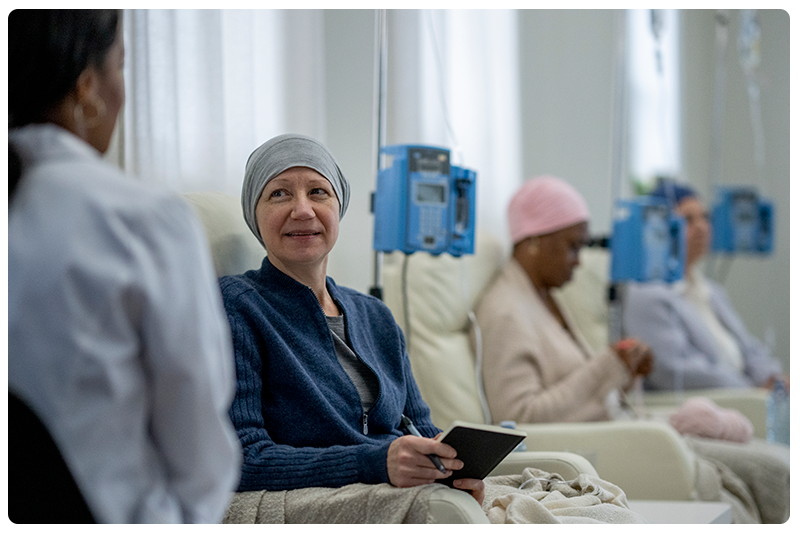From Experiment to Action: How Medicare is Transforming Cancer Care


BACKGROUND
Cancer is one of the most expensive and complex conditions to treat. But can better care for cancer patients also cost less?
An estimated 2 million individuals were diagnosed with cancer in 2024, and more than 610,000 die of cancer each year. Medicare covers nearly 60 percent of cancer patients in the U.S., spending billions of dollars annually. With an aging population, the human and financial costs of cancer continue to rise.
The Centers for Medicare and Medicare Services (CMS) launched the Oncology Care Model (OCM) in 2015 to see whether investing in higher-quality care for oncology patients would help mitigate rising costs of cancer care. A first-of-its kind payment reform pilot, OCM was a voluntary episode-based alternative payment model designed to improve the value of care for fee-for-service Medicare beneficiaries receiving chemotherapy for cancer.
Oncology physician practices that participated in OCM received monthly payments for enhanced oncology services (MEOS) care coordination of $160 per patient per month. And CMS made performance-based payments if practices met cost and quality goals.
Over the six-year implementation period, OCM included more than 4,500 oncologists across 33 states, serving more than 600,000 Medicare beneficiaries. Under OCM, episodes included all payments for health services provided during a six-month period, starting when patients began chemotherapy. While active, the model reached nearly a quarter of all eligible traditional Medicare chemotherapy episodes.
WHAT WE'RE DOING
Generating evidence that can improve healthcare.
Abt Global led a team that evaluated OCM’s ability to lower care costs while maintaining care quality.
The team used a mixed-method difference-in-differences evaluation design, with a carefully constructed comparison group, to measure whether OCM led to changes over the model’s lifespan. The evaluation focused on several research questions:
- What were the impacts of the OCM on the costs and quality of cancer care?
- How did care delivery change under the OCM?
- Which OCM design elements contributed most to success? and,
- Which contextual factors affected program success?
IMPACT
Evolving evidence and emerging impact.
The final results were mixed.
Despite substantial efforts to transform cancer care, these changes did not always lead to detectable improvements in clinical or quality outcomes. The findings showed that OCM was an important impetus for participating providers to transform their practices with patient-centered improvements:
- Better and faster access to clinicians, including a dedicated phone line, especially for supportive care (e.g., pain, nausea, other side effects)
- Reorganized care teams, workflows, and communication to support patients more holistically
- Patient navigation through confusing treatment protocols
- Attention to psychosocial needs, pain, and depression
Person-centered end-of-life care - Expanded same-day and after-hours supportive care
- More financial counseling about treatment plans, out-of-pocket costs, and resources to cover them.
However, these care process transformations did not always result in improved clinical and quality outcomes when compared to non-participating practices.
Even so, both oncologists and patients agreed on some positive impacts, especially improved communication. Oncologists highlighted the importance of proactive outreach and follow-up with patients to monitor side effects and refill needs. Patients shared that communication was a key driver of satisfaction with cancer care teams.
Cost reductions were real but insufficient to offset the incentive payments. OCM led to a 2.1 percent reduction in episode payments, with an especially strong decrease in the last two years of the program. Reductions were concentrated in the treatment for higher-risk cancers – high-risk breast cancer, lung cancer, colorectal cancer, and lymphoma.
One goal of OCM was to incentivize the use of higher-value (meaning more cost-conscious) treatment alternatives and better adherence to clinical guidelines. And the findings revealed progress, in part. Most savings—nearly one-third of the overall reductions in payments—were driven by decreased spending on non-chemotherapy drugs, through higher-value use of supportive care to prevent neutropenia and cancer-related bone fractures. OCM also contributed to the adoption of several higher-value biosimilar anti-cancer treatments. But chemotherapy drug costs remain the single largest contributor to total episode payments, and the evaluation found limited evidence for increased adoption of higher-value chemotherapy through OCM.
Most savings were driven by oncology practices that adopted two-sided risk arrangements in the last two years of the model – meaning the practices could earn higher incentive payments for meeting cost-reduction goals but also had to pay CMS back if their costs increased.
Ultimately, OCM did not achieve its goal of net savings for Medicare. Episode cost savings were generated, but not enough to offset the costs of the incentive payments. However, the net losses diminished over time as payment reductions grew so by the end of the model’s performance period, the model was nearly breaking even. This suggests that some changes took time to be fully implemented—and their effects wholly realized.


WHY THIS MATTERS
Health care delivery transformation and cost savings can go hand in hand, but outcomes are not always immediate.
Policy makers are listening. OCM holds promise for current and future models. The reductions in episode payments increased substantially over time: OCM nearly broke even by the last performance period.
CMS commitment to testing and adapting models will inform the future of complex care transformation and value-based payment reform. OCM’s successes and shortfalls offer powerful insights into future redesigns. The Enhanced Oncology Model (EOM) launched in 2023 as a successor to OCM, its design influenced by this and other evidence.
As cancer prevalence and treatment costs rise in the U.S., these models are not simply pilots. They are essential tools that help secure the future of Medicare and its role in covering cancer care for millions. For patients, it may mean better access, less fragmentation, and more engaged care. For the system, evidence-informed programs help align payment with what matters most: helping people live better, longer, and healthier lives—without breaking the bank.
Project
Evaluation of the Oncology Care Model
Client
U.S. Centers for Medicare & Medicaid Services
